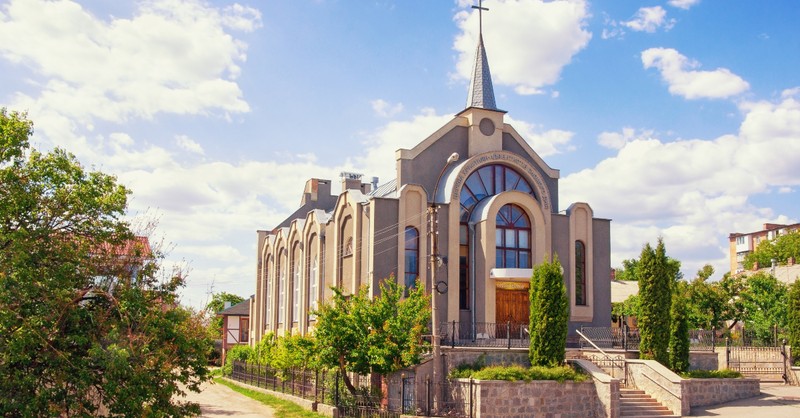10 Things Everyone Should Know about Seventh-Day Adventists and Their Beliefs
- Amanda Casanova ChristianHeadlines.com Contributor
- Updated Sep 28, 2023

Like many other Christian denominations, the Seventh-Day Adventist Church believes in a core set of beliefs about God and salvation.
Where this church differs from others stems from its own 28 Fundamental Beliefs, which outline the church’s specific beliefs on topics such as their well-known Saturday as Sabbath day. There are many sects of the church, but most fall under the guidance and direction of the authority of what’s called the General Conference.
Here are ten things to know about Seventh-Day Adventists:

1. Seventh-Day Adventists started in the 1800s as a denomination.
During a time of religious revival in the northeastern United States, many religious movements began, including early Seventh-Day Adventists. It was during the Second Great Awakening that preacher William Miller predicted Christ’s return on October 22, 1844. When he was wrong (called the Great Disappointment), his following of Millerites split into several groups, including what would become modern Seventh-Day Adventists, who said the date was correct, but that on that date, Jesus had begun the last phase of his atoning ministry in the “sanctuary in heaven.”
The few hundred Seventh-Day Adventists grew to about 3,000 by 1863, which is considered the official establishment of the church. In the late 1840s, the Adventist church was mostly made up of scattered groups where many disagreed on certain issues. Later, co-founder James White helped push forward a constitution for the many churches to unify under and named the denomination Seventh-Day Adventist.
Photo courtesy: © Getty Images/PeopleImages

2. Seventh-Day Adventists follow a doctrine called the 28 Fundamental Beliefs.
The document that Seventh Day Adventists ascribe to is the 28 Fundamental Beliefs, which discuss the teachings of “Holy Scriptures.” They are categorized as doctrines of God, man, salvation, church, Christian life and end day events.
The beliefs about God are: the Bible as the Word of God; the Trinity as a unity of God, the Father and the Son; the Father as the creator; the Son as the God incarnate; the Holy Spirit as an inspiration for the scriptures.
Other beliefs are that God created the world in six days; humans are fallen; the conflict between Christ and Satan is a “great controversy.” On Salvation, the church says that the resurrection of Christ is atonement for human sin and that Jesus saves man. A full list of those 28 beliefs can be seen here.
Photo courtesy: ©Thinkstock/David Greitzer

3. The Seventh-Day Adventist Sabbath is on Saturday
Seventh Day Adventists believe that the Sabbath begins at the end of the sixth day, which is considered Friday and lasts one day, which is Saturday. The Sabbath “protects man’s friendship with God and provides time essential for the development of that relationship.”
For that reason, on the Sabbath, there can be no secular labor, including any household tasks. Members are asked to “greet the Sabbath with the tranquility of mind.” Worship services are held on the Sabbath for the church for both worship and fellowship. Other rules for the Sabbath include avoiding weddings and funerals; however, the church does allow for seeking emergency healthcare on the Sabbath. Families are also encouraged to fellowship together over a meal.
You can read a full description of Adventist Sabbath observances here.
Photo courtesy: ©GettyImages/miwa_in_oz

4. Seventh-Day Adventists believe in what’s called Heavenly Sanctuary.
Seventh Day Adventists believe that there is a sanctuary in heaven set up by God. There, Christ ministers on our behalf. In the first phase of this, called the ascension, Jesus became High Priest of this sanctuary. In 1844 at the end of a prophetic period of 2,300 days, Jesus entered the second phase of his atoning ministry. During this phase, Jesus’ work at the heavenly sanctuary is on eradicating all sin.
A judgment also reveals who among the dead are asleep in Christ and are then worthy to take part in the resurrection of Christ. Those who are living in Christ when this happens are able to enter the kingdom.
The Heavenly Sanctuary is considered the heavenly model for the Old Testament sanctuaries. What Israelite priests did in those sanctuaries is what Christ is now doing for us.
Photo courtesy: ©GettyImages/shunli zhao

5. Many Seventh-Day Adventists still follow the teachings of the prophet Ellen White.
Among the early leaders of the Seventh-Day Adventist church was Ellen White, whose writings stemmed from her gift of prophecy. Some of White’s writings are practical and deal with the topic, such as teaching girls to harness and drive a horse, but Seventh Day Adventists say many of her other teachings still apply today.
Her most known work was called “Steps to Christ,” where she answered questions on how to deal with doubt and also understanding the difference between grace and law. It’s been hailed as giving a practical approach to Christianity. For example, she writes, “Prayer is the opening of the heart to God as to a friend. Not that it is necessary in order to make known to God what we are, but in order to enable us to receive Him.”
Her book has been published in more than 165 languages. In 2014, the Smithsonian Magazine named White as one of 100 Most Significant Americans of All Time.
Photo courtesy: ©Thinkstock/bestdesigns

6. Seventh-Day Adventists believe death is an unconscious state.
According to the 28 Fundamental Beliefs, the wages of sin is death, but God will give eternal life to his followers. Until Christ returns, death is an unconscious state for all people.
This belief comes from Ecclesiastes 9, which says, “For the living know that they will die.” Another verse often pointed to for this belief is 1 Thessalonians 4:13-18, which says, “For we believe that Jesus died and rose again, and so we believe that God will bring with Jesus those who have fallen asleep in him. According to the Lord’s word, we tell you that we who are still alive, who are left until the coming of the Lord, will certainly not precede those who have fallen asleep. For the Lord, himself will come down from heaven … After that, we who are still alive and are left will be caught up together with them in the clouds to meet the Lord in the air.”
Sleep for death is an oft-used metaphor in the bible for death, and Adventists believe that eternal life will come to believers when Jesus returns.
Photo courtesy: © Getty Images/Kara Gebhardt

7. Seventh-Day Adventists believe Jesus is coming back.
Like other Christian denominations, Seventh-Day Adventists hold to the belief that Jesus is returning. They believe it will be “visible and worldwide,” according to their doctrine. At that time, the righteous dead will be resurrected and taken to heaven.
Although the early Seventh-Day Adventist church (even before it was known as the Seventh-Day Adventist Church) tried to predict Jesus’ return, today, the church says it does not know the exact time and date. It does, however, say in their doctrine that many events that precede the Second Coming have fulfilled prophecy, meaning the return of Jesus is soon. For that reason, they believe in being constantly ready. The church calls the Second Coming the “blessed hope of the church” and the “grand climax of the gospel.” Advent, itself, means “coming.”
Photo courtesy: ©Thinkstockphotos.com

8. Seventh-Day Adventists might have better longevity than others.
Many Seventh-Day Adventists ascribe to a vegetarian or plant-based diet. They take this direction from scripture, which says God gave nuts, grains, and herbs as nourishment.
Because of this diet, many experts have said Seventh-Day Adventists can live an average of 10 years longer than most Americans. In a study from Loma Linda University, scientists found that Adventists can die of cancer, stroke or heart disease, but the age at which those diseases and illnesses are diagnosed is much later because of their healthy lifestyle and resting on the Sabbath.
In addition to a plant-based diet, many churches also forbid alcohol and tobacco. The doctrine reads: “Such health is a gift from a loving God who wants us to live life in its abundance.”
Photo courtesy: © Getty Images/KatarzynaBialasiewicz

9. Seventh-Day Adventists don’t believe hell is infinite torture.
Adventists believe that hell is not an eternity of suffering and torture. They believe God is just but also merciful and it’s not in the nature of God to torture the unrighteous for eternity. Instead, sinners and unbelievers will ultimately die for eternity.
Most Adventists believe some variant of annihilationism, which says that after final judgment, all unbelievers will be destroyed rather than suffering in hell. In this belief, the Old Testament and New Testament say that the final end for nonbelievers is total extinction. For example, in Romans, Paul describes hell as a final punishment, where the wicked die, perish or are destroyed.
Photo courtesy: © Getty Images/LoraLiu

10. The highest-ranking authority in the Seventh-Day Adventist Church is the General Conference.
Seventh-Day Adventists follow a hierarchal network with some 19 million members and 82,000 churches. The General Conference oversees the global ministry of the church. The General Conference is also responsible for the spiritual development of the church. It is headquartered in Silver Spring, Maryland.
The entire structure reflects a democratic process of election and formation.
Under the General Conference is the union conference, which comprises conferences and divisions by geographic location. Under union conferences are local conferences, which are made up of churches in a state or territory. Finally, the local church and its members are under local conferences.
Each church elects its own church boards and officers, as do the other divisions. Worldwide, there are 13 divisions of the Seventh-Day Adventist Church.
Photo courtesy: © Getty Images/fongleon356
Publication date: April 13, 2018
This article is part of our Denomination Series, listing historical facts and theological information about different factions within and from the Christian religion. We provide these articles to help you understand the distinctions between denominations, including origin, leadership, doctrine, and beliefs. Explore the various characteristics of different denominations from our list below!
Catholic Church: History, Tradition & Beliefs
Jehovah's Witnesses & Their Beliefs
Mormons: The Church of Latter Day Saints & Their Beliefs
Baptist Church: History & Beliefs
Presbyterians: History & Beliefs
Mennonites & Their Beliefs
United Methodist Church: History & Beliefs
Seventh-Day Adventists & Their Beliefs
The Pentecostal Church: History & Beliefs
Lutheran History & Beliefs


















